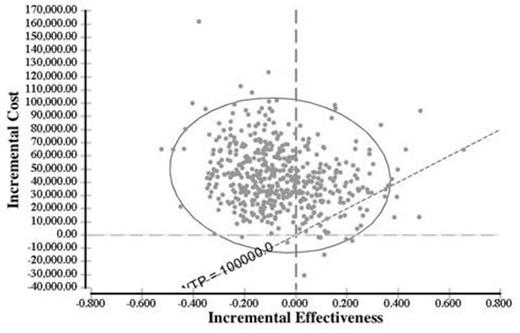Abstract
We analyzed and compared the cost-effectiveness of 2 strategies for treating CML patients -- using imatinib first in all (altering therapy as needed in a stepwise approach) or by physician’s choice, starting either imatinib or one of the approved second-generation tyrosine kinase inhibitors (TKIs) dasatinib or nilotinib. Currently, each TKI is patent-protected and commands about one-third of front-line CML treatment. Life-long treatment is recommended. Imatinib is losing patent exclusivity and facing generic competition presently in the US (in early 2016) and in EU member countries; its price is expected to drop 70-90% within two years following generic entry.
We constructed a Markov model simulating outcomes over 5 years when imatinib 400 mg is used first for all incident chronic phase CML patients, or alternatively by physician choice using any of the 3 TKIs first. The model assumes the commercial payer or health system perspective. In the stepwise approach, if imatinib fails, patients are switched to dasatinib or nilotinib in equal proportions. Patients are assumed to switch drugs if they were intolerant or failed standard efficacy endpoints: complete cytogenetic response (CCyR) or major molecular response (MMR) as defined in the ELN recommendations (Baccarani et al. Blood 2013). The model adjusts the price of imatinib over time as generic competition begins within each market: 100% of the branded price for first 6-months; 60-80% for the second 6-months; 10-30% thereafter.
For each drug, tolerance, efficacy and probabilities of treatment choice, failure, and switching were drawn from published clinical trials (principally IRIS, ENESTnd, DASISON, and second-line phase II and transplant studies) and used Sokal or Euro risk group data where available. Quality-adjusted life years (QALYs) were based on CML-specific health utilities (Szabo et al, 2010). For the US model, direct medical costs per patient were drawn from Marketscan (2001-2007) and included US annual drug prices: imatinib ($76,800), dasatinib and nilotinib ($102,000). Additional costs included patient monitoring, hospitalization, and allogeneic transplantation, if required. Costs and QALYs were discounted at 3% ($US; 2013 values). Univariate and multivariate sensitivity analyses tested parameters with the greatest impact on results. We also considered cost savings in years 4 and 5 from TKI discontinuation in a fraction of patients achieving MR4.5 in years 2 and 3. Results were interpreted from a willingness-to-pay (WTP) of $100,000/QALY.
Compared to physician choice starting any TKI regimen ($172,076; 3.36 QALYs) over the first 5 years, stepwise therapy costs less and offers clinically-equivalent utility ($147,091; 3.25 QALYs) when generic imatinib is available. Thus, stepwise therapy is estimated to have an incremental cost-effectiveness ratio (ICER) of $227,136/QALY. The ICER was favorable for stepwise therapy for each Sokal risk group.
The results are robust to changes based on univariate analyses of the most sensitive parameters (imatinib-associated probability of CCyR/MMR, price drops, and the health utility of suboptimal response or treatment failure). A Bayesian multivariate probabilistic sensitivity analysis using 10,000 Monte Carlo simulations suggested that stepwise therapy is cost-effective in 73.3% of simulations (point estimates above the diagonal WTP line in Figure 1). Limitations include efficacy data drawn from prospective trials; thus, results may not apply to patients with co-morbidities, older age, or lack of access to appropriate specialty care.
We conclude that when imatinib loses patent protection in 2016 in the US and its price declines, it will be the cost-effective initial treatment strategy for chronic phase CML compared to dasatinib and nilotinib. Our model and results demonstrate that system-level cost-effectiveness can be estimated based on country-specific (1) CML incidence and prevalence, (2) CML treatment patterns and associated costs across all medical inputs, including drugs, (3) expected date for loss of patent exclusivity, and (4) pricing policies for generic drugs and formulary placement decisions. Comparative cost-effectiveness data for the US, UK, and other selected EU countries will be presented.
Scatterplot of incremental cost-effectiveness ratios for physician’s choice vs stepwise therapy in Monte Carlo probabilistic sensitivity analysis
Scatterplot of incremental cost-effectiveness ratios for physician’s choice vs stepwise therapy in Monte Carlo probabilistic sensitivity analysis
Larson:Ariad: Consultancy, Research Funding; Bristol Myers Squibb: Consultancy, Research Funding; Novartis: Consultancy, Research Funding; Pfizer: Consultancy. Apperley:Ariad: Research Funding; Bristol Myers Squibb: Research Funding; Novartis: Research Funding; Pfizer: Research Funding. Baccarani:Ariad: Consultancy, Honoraria; Bristol Myers Squibb: Consultancy, Honoraria; Novartis: Consultancy, Honoraria; Pfizer: Consultancy, Honoraria. Eigendorff:Bristol Myers Squibb: Research Funding; Novartis: Research Funding. Martinelli:Ariad: Research Funding; Bristol Myers Squibb: Research Funding; Novartis: Research Funding; Pfizer: Research Funding. Mueller:Ariad: Research Funding; Bristol Myers Squibb: Research Funding; Novartis: Research Funding; Pfizer: Research Funding. Niederwieser:Novartis: Research Funding. Saussele:Bristol Myers Squibb: Research Funding; Novartis: Research Funding; Pfizer: Research Funding. Silver:Novartis: Research Funding. Hehlmann:Novartis: Research Funding; Bristol Myers Squibb: Research Funding.
Author notes
Asterisk with author names denotes non-ASH members.


This feature is available to Subscribers Only
Sign In or Create an Account Close Modal